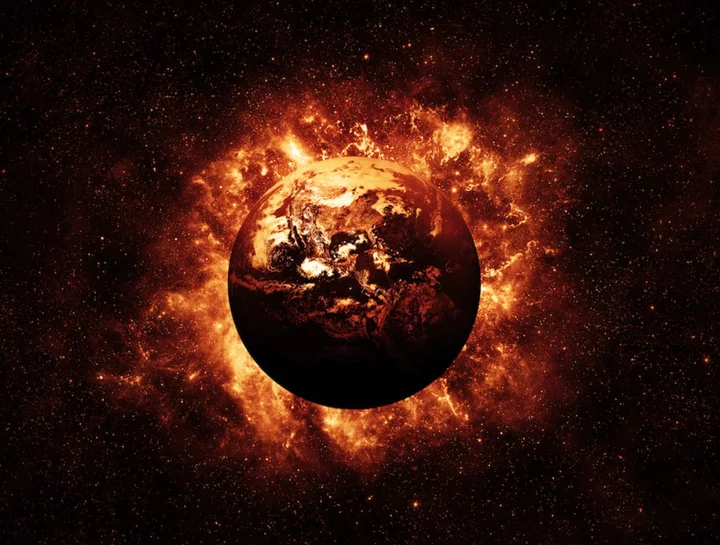Earth's mass extinctions have come for the dinosaurs and a whopping 95 percent of ocean species.
Mammals, like us, may be next — eventually.
In intriguing new research published in the science journal Nature Geoscience, scientists used a supercomputer to simulate the climate on our planet's next supercontinent, Pangea Ultima, which is expected to form in some 250 million years. The continent's monthly average temperatures skyrocket to between some 104 to 122 degrees Fahrenheit (40 to 50 Celsius), and in the warmest summer months, temperatures would average up to a deadly 158 Fahrenheit (70 C).
For reference, today Earth's average temperature is 59 F (15 C).
Much of the landmass wouldn't have water to drink or grow food. Mammals — those who stay on Earth's surface, that is — wouldn't be able to physiologically withstand such a relentless onslaught of heat, the study's authors conclude.
"Humans – along with many other species – would expire due to their inability to shed this heat through sweat, cooling their bodies," Alexander Farnsworth, the study's lead author who researches past, present and future climate at the University of Bristol, said in a statement.
SEE ALSO: Earth's core is wilder than you can imagine The projected monthly temperatures on Earth's future supercontinent, Pangea Ultima. Credit: University of BristolExtreme heating on Pangea Ultima
Mammalian life may still survive on the outer fringes of the supercontinent, meaning the higher latitudes where temperatures are moderate. But most of this future land, some 84 to 92 percent, would be hellish and uninhabitable. Researchers used a widely employed climate model, one of the UK Meteorological Office's HadCM3 models, to simulate conditions on Pangea Ultima. (Climate models like HadCM3 have proven incredibly accurate at predicting Earth's recent warming.)
Here's why it would get so hot:
- Carbon dioxide would skyrocket in the atmosphere: The amount of heat-trapping carbon dioxide gas in the atmosphere largely controls Earth's climate. That's why the planet's temperature is currently increasing. Fortunately, this is controllable heating — the burning of fossil fuels drives today's heating. But when the continents collide, geologists expect rampant volcanism to ramp up (as it likely has before), relentlessly releasing carbon dioxide into the skies.
"We think CO2 could rise from around 400 parts per million (ppm) today to more than 600 ppm many millions of years in the future," Benjamin Mills, a biogeochemical modeller at the University of Leeds who worked on the research, said in a statement. "Of course, this assumes that humans will stop burning fossil fuels, otherwise we will see those numbers much, much sooner.”
- The supercontinent's location: Pangea Ultima is expected to primarily form in the hottest part of Earth: the sweltering tropics where Earth receives the most sunlight. It's also humid there, owing to warm ocean water evaporating into the tropical atmosphere. Crucially, humidity, which means more moisture in the air, makes air temperatures feel hotter while making it difficult (or impossible) to evaporate away body heat.
- The continentality effect: The interior of continents are far from the moderating influence of the ocean. Los Angeles, for example, experiences a cool marine breeze that California's inland deserts don't. Much of Pangea Ultima, as all seven of Earth's continents scrunched together, won't be exposed to oceanic influences, allowing the vast, singular inner continent to bake.
- Sun's increased brightness: Although our star is stable, it's slowly growing brighter. Every 100 million years, the sun's luminosity increases by about 1 percent. In 250 million years, this added brightness will further exacerbate heating on Pangea Ultima.
"With the Sun also anticipated to emit about 2.5 percent more radiation and the supercontinent being located primarily in the hot, humid tropics, much of the planet could be facing temperatures of between 40 to 70°C," Farnsworth said.
Want more science and tech news delivered straight to your inbox? Sign up for Mashable's Light Speed newsletter today.
The distant future climate of Pangea Ultima is an intriguing study in where our planet, and species, are headed. But the news isn't all bad. After all, 250 million years is awfully far away. By that time, we'd almost certainly have a plan, like we're developing for incoming asteroids.
And if we're still around in 250 million years to face the coming onslaught of supercontinental heat, that means we deftly navigated our way through the likes of human-caused climate change, threatening space rocks, and worldwide plagues. What an achievement that would be.









